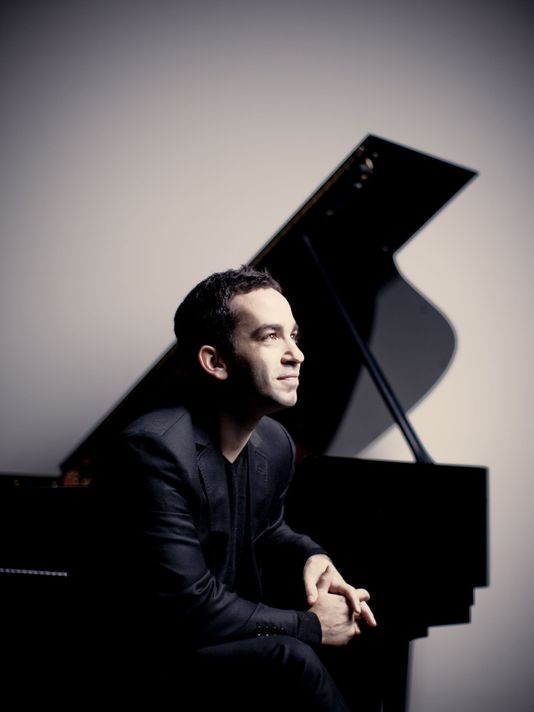Stirring Schumann and richly Romantic Mendelssohn from Barnatan, Vänskä, and New World Symphony

Inon Barnatan performed Schumann’s Piano Concerto with Osmo Vänskä and the New World Symphony Friday night in Miami Beach. Photo: Marco Borggreve
Inon Barnatan gave a performance of the Schumann Piano Concerto Friday in Miami Beach that sounded like the way the piece was meant to be played.
Despite the burden of what must have been the squeakiest piano stool in Florida, he delivered a performance that was delicate without fussiness, poetic without a loss of rhythmic pulse and joyful without a trace of heaviness.
Barnatan, an Israeli who now lives in New York, found exceptional partners in the New World Symphony led by guest conductor Osmo Vänskä, music director of the Minnesota Orchestra.
In the opening theme, winds shaped the melody with particular richness and eloquence. The orchestra played with a rounded tone and forthright manner in the stirring second theme, which represented Schumann at his most engaging. In the middle of the movement, the collaboration was especially pronounced, as piano and winds exchanged accounts of a longing, sighing melody.
This is not among the most difficult works in the repertoire, but technique still matters. Barnatan played with easy fluency in fast passages. He brought a range of colors to the performance—playing with playful delicacy in the Intermezzo, stern force in the cadenza and a rumbling energy in the heroic passages of the concluding Allegro vivace. The final movement came off as just the joyful, affirmative statement it should be, with Barnatan bringing particularly exuberant playing to the fast passages in the middle of the keyboard with which the movement climaxes.
As an encore, he performed Mendelssohn’s Rondo Capriccioso, playing with songlike sensitivity in the opening melody and then light, whirling virtuosity in the bravura closing section.
The concert opened with “Winter Sky,” part of a larger orchestral work titled Orion by the contemporary Finnish composer Kaija Saariaho. The performance was led by New World conducting fellow Dean Whiteside.
An austere work, “Winter Sky” sounds like a descendent of the most wintry side of her country’s musical patriarch Sibelius. The music has a unique, compelling texture, with pianissimo percussion, harp, strings and piccolo creating a high, glassy sound, while soft tones in trombone, tuba and bass establish a sense of understated power.
At first, it appears the work will be all atmospherics, a portrait of clear skies on an icy night, with nothing happening. A mysterious descending figure repeats, as Whiteside led the orchestra through an almost imperceptible crescendo. Dissonances crept in, as the music started sliding downward to an eerie climax. It ended largely where it began, with high, soft glassy tones.
What was most striking about the performance was the musicians’ ability to maneuver at pianissimo volume, establishing a finely calibrated balance from piccolo to tuba—essential for music that relied heavily on its unique aural texture—and generating a crescendo that stretched for a long duration.
Mendelssohn may have been among the most Classical of the early Romantic composers, with his fascination with the music of the past, satisfaction with traditional forms and precise compositional style. But under Vänskä, the orchestra gave a performance of the composer’s Symphony No. 3, known as the “Scottish,” that was richly Romantic, with grand sweep and unrestrained emotion.
The orchestra’s burnished tone was an asset throughout this atmospheric music. In the opening, violas and winds played with a rich timbre, establishing the misty, wistful mood. Vänskä drew maximum suspense from the music, generating a dramatic performance that had almost Beethovenian weight and force, while retaining Mendelssohn’s characteristic smoothness and transparency.
Winds gave a rolling, rollicking account of the Scherzo. The Adagio was completely absorbing, with violins playing out in the big, soft-focus melody, and a grand, processional passage, with rumbling timpani, in the movement’s climax.
The final movement, marked Allegro guerriero (“warlike”), was sleek and exciting, with abrupt horn calls and Vänskä calling for extra force from the lower strings, which responded with grinding, craggy tones. The affirmative, major key ending of the work can sometimes feel like it came out of nowhere. But under Vänskä, the orchestra gave it unusual weight and dignity, making a convincing and resounding coda for the symphony.
The program will be repeated 7:30 p.m. Saturday at New World Center in Miami Beach. nws.edu; 305-673-3331.
Posted in Performances
Leave a Comment
Sat Mar 9, 2019
at 1:51 pm
No Comments







